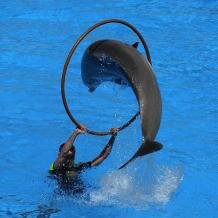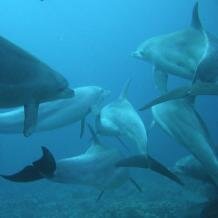Topic: Dolphin communication, cognition and sociality
Dolphins are one of the most intriguing sources of evolutionary convergence, having cognitive abilities that seem to find many parallels in the great apes, and rather remarkably even extend to tool use.
Dolphins are amongst the most popular of animals, notable for their playfulness and intelligence, and also for their associations with humans from assistance to fishermen and swimmers in distress to stories that have entered folk-lore (nor should we assume all the stories are as tall as de-racinated urbanities sometimes assume).
Shape and locomotion
In general terms the stream-lined shape of dolphins is convergent on a number of other ocean-going animals, such as the extinct ichthyosaurs. Just as there is a striking convergence between the tuna and lamnid sharks which depends critically on key features of the location of the red aerobic muscles and associated tendons that transmit the propulsive forces to the large tail, so too there are interesting convergences between the dolphins and scombrid fishes in terms of force transmission.
Aside from their body shape, dolphins are one of the most intriguing sources of evolutionary convergence because of possessing cognitive abilities that seem to find many parallels in the great apes, and rather remarkably even extend to tool use.
Communication and language
 Linked to their cognitive abilities features is a sophisticated system of communication, and whilst there is debate as to the extent of similarity to human communication there is evidence that dolphins are competent in both semantic and syntactical modes, that is given instructions of a string of “words” (and these may be transmitted by hand signals or underwater sounds) the dolphin will perform the appropriate action, but when the same “words” (i.e. semantics) are re-ordered to give a new “sentence” structure the appropriate command is obeyed. Given this degree of sophistication it is not surprising that some investigators are suggesting dolphins may recognize each other by different “names”. So too they are accomplished vocal mimics, a feature found in a number of the more intelligent animals, notably parrots and humans. The suggestions that some types of communication, notably the so-called signature whistles, carry very specific and precise sorts of information have led to some controversy. Even so it is evident that dolphin communication not only shows plasticity in its behaviour, but that the processes of vocal learning in the young have interesting parallels to bird song and also human speech, including a “babbling” phase.
Linked to their cognitive abilities features is a sophisticated system of communication, and whilst there is debate as to the extent of similarity to human communication there is evidence that dolphins are competent in both semantic and syntactical modes, that is given instructions of a string of “words” (and these may be transmitted by hand signals or underwater sounds) the dolphin will perform the appropriate action, but when the same “words” (i.e. semantics) are re-ordered to give a new “sentence” structure the appropriate command is obeyed. Given this degree of sophistication it is not surprising that some investigators are suggesting dolphins may recognize each other by different “names”. So too they are accomplished vocal mimics, a feature found in a number of the more intelligent animals, notably parrots and humans. The suggestions that some types of communication, notably the so-called signature whistles, carry very specific and precise sorts of information have led to some controversy. Even so it is evident that dolphin communication not only shows plasticity in its behaviour, but that the processes of vocal learning in the young have interesting parallels to bird song and also human speech, including a “babbling” phase.
Memory and intelligence
 Other aspects of cognitive ability are evident in tests relevant to memory and mirror-self recognition (convergent, but highly unusual and apart from humans only reliably documented in a handful of animals, including the elephants). In addition their apparent intelligence is expressed in numerosity and playfulness, illustrated in remarkable studies on the production and manipulation of bubble rings, pointing and gaze comprehension, and even the dither factor (shall I, shan’t I, shall I, maybe, bother …). The net conclusion is that the cognitive world of dolphins maps closely, and convergently, on that of the great apes. There is also, of course, an interesting parallel to the cognitive abilities of the birds, especially the crows and parrots.
Other aspects of cognitive ability are evident in tests relevant to memory and mirror-self recognition (convergent, but highly unusual and apart from humans only reliably documented in a handful of animals, including the elephants). In addition their apparent intelligence is expressed in numerosity and playfulness, illustrated in remarkable studies on the production and manipulation of bubble rings, pointing and gaze comprehension, and even the dither factor (shall I, shan’t I, shall I, maybe, bother …). The net conclusion is that the cognitive world of dolphins maps closely, and convergently, on that of the great apes. There is also, of course, an interesting parallel to the cognitive abilities of the birds, especially the crows and parrots.
Brain structure and echolocation
Even though both apes and dolphins are mammals, there are highly significant differences in the brain structure. For example, not only are there cellular differences, but the proportions of the brain regions differ quite markedly. Dolphins, for example, have a disproportionately large cerebellum, and it is possible this is linked to another interesting example of convergence, the evolution of echolocation independent of the bats and also the birds. Like the bats the echolocation has remarkable finesse, enabling the dolphin readily to recognize and distinguish small objects. In addition there is evidence that the sensory input from echolocation can be combined with vision (a process known as cross-modal recognition).
Sociality
 Not surprisingly, given their rich cognitive world and communication the dolphins live in complex societies based on the fission-fusion type. They thus show an interesting convergence with such groups of primates as the chimpanzees and some New World monkeys. In this arrangement there is a loose set of alliances amongst a group of about 100 dolphins. Typically, a small number of males form a tight-knit and longer-lived association, one purpose of which is the corralling and coercion of females for reproductive purposes, often with considerable violence.Whilst fission-fusion communities are the norm there are exceptions. A particularly interesting case involves spinner dolphins living around a remote Hawaiian atoll where apparently the safety from predation by sharks has led to a bisexual sociality (which interestingly is also found in the Tai chimpanzees). A somewhat similar organization is found in Doubtful Sound, and may also reflect geographical isolation.
Not surprisingly, given their rich cognitive world and communication the dolphins live in complex societies based on the fission-fusion type. They thus show an interesting convergence with such groups of primates as the chimpanzees and some New World monkeys. In this arrangement there is a loose set of alliances amongst a group of about 100 dolphins. Typically, a small number of males form a tight-knit and longer-lived association, one purpose of which is the corralling and coercion of females for reproductive purposes, often with considerable violence.Whilst fission-fusion communities are the norm there are exceptions. A particularly interesting case involves spinner dolphins living around a remote Hawaiian atoll where apparently the safety from predation by sharks has led to a bisexual sociality (which interestingly is also found in the Tai chimpanzees). A somewhat similar organization is found in Doubtful Sound, and may also reflect geographical isolation.
Dolphin societies have a number of interesting aspects. For example, organized foraging with either division of labour or specialized beach hunting has been recognized (and there are also well documented instances of co-operation with fishermen), whilst in the case of tool use the cultural information about the use of the sponges (evidently as protective gloves on the rostrum) is transmitted from mother to daughter. Dolphins are famous for their beautiful co-ordinated swimming (where it may serve as an adaptive signal for an alliance), and in addition they show an interesting convergence in terms of sleep because like the birds they keep one eye open, (so only half the brain is asleep), although this occurs of course during swimming and probably helps the individual to keep track of its neighbours. Another aspect of sociality that deserves comment is the reaction to death, a rare phenomenon amongst animals and one also found in the elephants.
Cite this web page
Map of Life - "Dolphin communication, cognition and sociality"
https://mapoflife.org/topics/topic_159_dolphin-communication-cognition-and-sociality/
November 25, 2020

